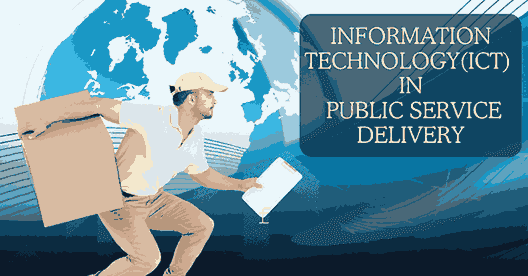Service delivery has become increasingly crucial in today's digital landscape, with Information and Communication Technology (ICT) revolutionizing government interactions with citizens. This technology enhances efficiency, accessibility, and service quality, reducing time and cost while increasing the quality of services. By utilizing ICT more often, inconsistencies can be minimized, and a timely service delivery environment can be established. Technology promotes governance concepts like accountability, openness, and equitable access to information, making it essential for meeting the evolving needs and expectations of citizens. However, challenges and negative impacts must be addressed to ensure progress in service delivery. In this blog, we will explore the role of information Technology in Public service delivery.
Introduction of Public Service
The services and facilities available to the public on behalf of the state are called general economic services. The services provided by the state to complete citizenship by stating that various services are available to you are called public services. Common citizens to be equal to receive public services equally. The system of this state is settled. All problems of goods or services provided by the state to the people to govern.
Role of Information Technology in Public Service
To create access to information and to store, transfer, and alter it as needed, information and Computer technology and telecommunication services are combined to form communication technology. These tools include computer hardware, software, networking, multimedia, telephone, mobile, internet, website etc.
Information and communication technology is the latest concept in public service delivery. The concept of public service developed in 1980 or recent days has been guided by concepts such as citizen charter, good governance, new public management, privatization and new public service, information communication, and technology use. The use of information communication and technology is the latest means. Before that, it was only understood as information technology.
Positive effects of the use of information technology in the field of public service delivery
Data and correspondence innovation can connect the public authority individuals relationship, information movement, and incredible organizations, while similarly engaging clients to learn about citizen upheld drives and neighborhoods. Since the people can bring their problems, complaints, and suggestions directly to the government, their satisfaction with the service increases and the relationship between the people and the government or stakeholders is maintained. In a country like Nepal where there is a geographical problem, service delivery can be made faster and more efficient. Its other effects are as follows.
- The concept of e-governance can be embodied
- By developing a reliable and trustworthy record system, the decision-making process can be made practical
- Office automation is possible
- A Management Information System can be developed
- Implementation of paperless bureaucracy and recognition of paperless administration
Negative impact of information and communication technology
The use of technology seems essential to streamline public service delivery, but in a country like Nepal, there may be many challenges to advancing public service delivery through technology. Existing illiteracy, lack of access to technology in many areas, the tendency to work according to the old style, dissatisfaction to work with new technology, education is not technology friendly, even the educated class does not know how to use technology properly, etc. Its other negative effects are as follows.
- Privacy may be breached
- Question on the authority of information
- Possibility of social crime
- Crisis on original art culture and small and cottage industries
- Violations including cybercrime may increase
- Over-reliance on technology, creativity, and exploration can be lost
- Theft of information
- Possibility of job cuts
- Widening the digital divide
- Server hacking and high investment required for security
- Problems in environmental management, etc.
Conclusion
In the modern age based on today's information technology, government services must be made quality, people-friendly, and efficient through the use of new technology. This will reduce the time and cost of service delivery and increase the quality.
By utilizing information and communication technology more often, service delivery inconsistencies may be minimized and a timely service delivery environment can be established. Since information technology is necessary to promote fundamental governance concepts like accountability, openness, and equitable access to information, more information and communication technology should be used to supply public services.
Read More...

